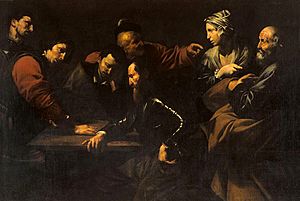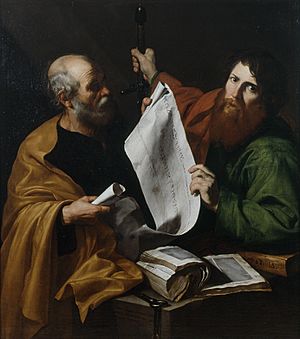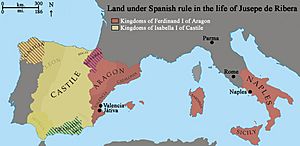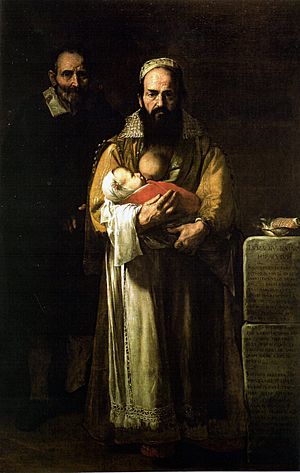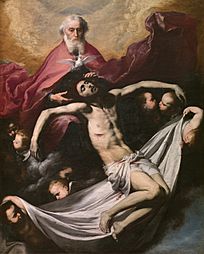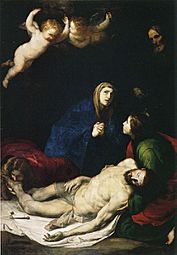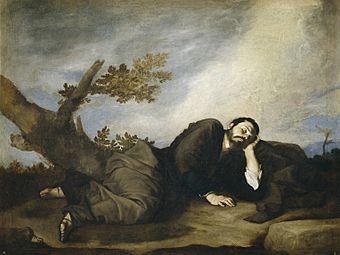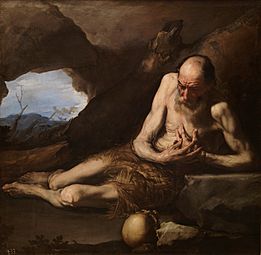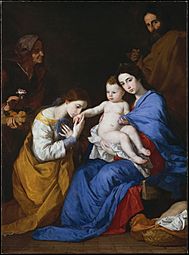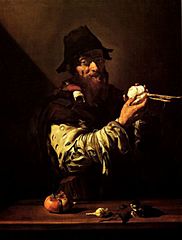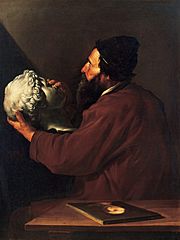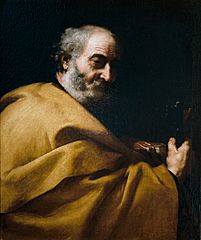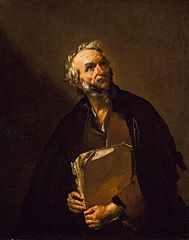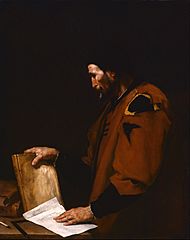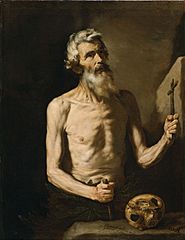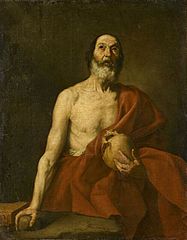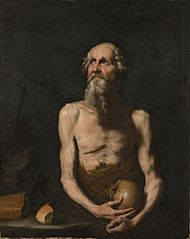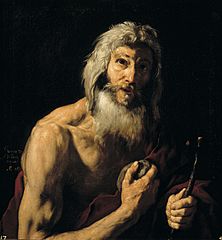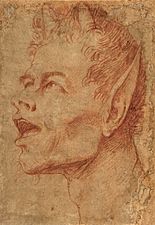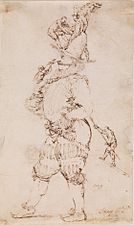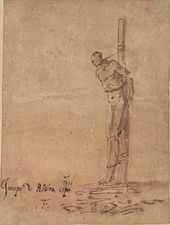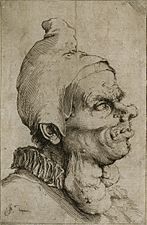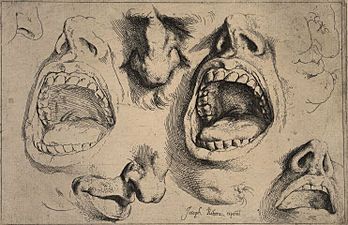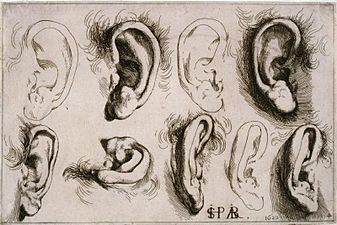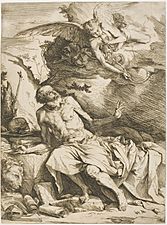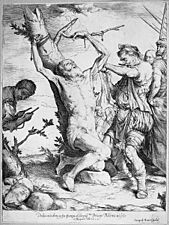Jusepe de Ribera facts for kids
Quick facts for kids
Jusepe de Ribera
|
|
|---|---|
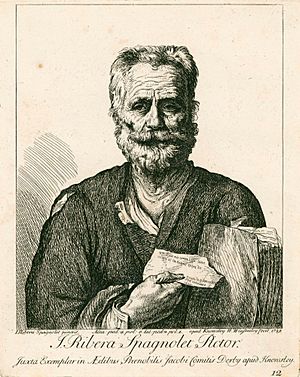
Copy of Saint Thomas (purported Ribera self-portrait) engraved by Hamlet Winstanley
|
|
| Born | February 17, 1591 (baptized) |
| Died | November 3, 1652 (aged 61) Mergellina, Naples, Italy
|
| Occupation | painter and printmaker |
| Years active | 1611 – 1652 |
| Known for | Drunken Silenus, Magdalena Ventura with Her Husband and Son, The Martyrdom of Saint Philip, Clubfooted Boy, The Holy Family with Saints Anne and Catherine of Alexandria |
| Movement | Baroque |
Jusepe de Ribera (1591 – 1652) was a famous Spanish painter and printmaker. He is considered one of the most important artists of the Spanish Baroque painting period. Other great artists from this time include Francisco de Zurbarán, Bartolomé Esteban Murillo, and Diego Velázquez. Experts agree that Ribera was not only the best artist in Naples during his time but also one of Europe's top masters in the 1600s. People sometimes called him José de Ribera, Josep de Ribera, or even Lo Spagnoletto, which means "the Little Spaniard."
Ribera painted many different subjects. He created history paintings, which included stories from the Bible and Greek mythology. He is especially known for his powerful paintings of martyrdom, showing people suffering for their beliefs. He also painted portraits, still lifes (pictures of objects), and landscapes. Many of his paintings show ordinary people like workers and beggars. He often painted older individuals in worn clothes, making them look like philosophers, saints, or other important figures.
Ribera's early paintings are known for their strong realism. He used a style called chiaroscuro or tenebrism. This style uses strong contrasts between light and dark to create dramatic effects. Later in his career, he started using more colors and softer light. His compositions became more complex, but he always kept some of his early, intense style.
Contents
Life
Early Life and Training
We don't know much about the first 20 years of Jusepe de Ribera's life. He was baptized on February 17, 1591, in Játiva, Spain. His father was a shoemaker. The first record of his art career is from 1611. He was paid for a painting for a church in Parma, Italy, but this painting is now lost.
By October 1613, Ribera was a member of the Accademia di San Luca in Rome. He lived in a part of Rome known as "the foreigner's quarter" with his brothers and other artists. Stories from that time say he quickly became a famous painter in Rome and made a lot of money. However, they also said he could be lazy and spent money very quickly.
Some early stories about Ribera's life were not true. For a long time, people thought he was born in 1587 or came from a noble family. But later research showed these ideas were wrong. It was also believed he studied art in Valencia with a painter named Francisco Ribalta. While this is possible, there is no real proof.
Ribera's family life might have been a bit difficult. His father remarried twice when Jusepe was young. Some historians now think Ribera might have been in Italy as early as age 14 or 15. His drawing style also suggests he learned art in Italy.
In 1611, when he was only 20, Ribera received an important job in Parma, Italy. He was asked to paint Saint Martin Sharing His Cloak with a Beggar for a church. This shows he already had a good reputation. The painting is now lost, but copies exist.
Rome was a very important art center at this time. Many artists from all over Europe came there. They were exploring new ways of using light and shadow, inspired by the artist Caravaggio. Ribera was one of these artists. He was praised by other painters, who said he was very bold and experimental.
Life in Naples
In late 1616, Ribera moved to Naples, Italy. At that time, Naples was ruled by Spain. In November 1616, he married Caterina Azzolino. Her father was a painter, and his connections helped Ribera become a major artist in Naples. Because he was Spanish, he also had good connections with the Spanish rulers and art collectors in the city. From this point on, Ribera often signed his paintings as "Jusepe de Ribera, español" (Jusepe de Ribera, Spaniard).
He quickly caught the attention of the Viceroy, the Spanish ruler of Naples. The Viceroy gave him many important painting jobs. Ribera's career grew stronger in the late 1620s, and he became the leading painter in Naples. In 1626, he received a special honor called the Cross of the Order of Christ from Pope Urban VIII.
Even though Ribera never went back to Spain, many of his paintings were taken there by Spanish officials. His etchings (a type of print) were also sold in Spain. His style influenced many Spanish painters, including Velázquez and Murillo.
Some stories say that Ribera was part of a group of artists who tried to control art jobs in Naples. This group supposedly tried to scare away other artists who came to work in the city. However, there is no real proof of these stories.
Ribera had many students, including Luca Giordano and Hendrick de Somer. His work also influenced other painters in Naples.
Later Years
Around 1644, Ribera's health started to get worse. This made it harder for him to work, but his workshop continued to produce paintings under his guidance. During a rebellion against Spanish rule in 1647–1648, he and his family had to hide in the Viceroy's palace. By 1651, he sold his home and was having money problems. Jusepe de Ribera died in September 1652.
His Artworks
Ribera's early art was influenced by Spanish and Venetian masters, as well as by Caravaggio. His paintings often showed intense and dramatic scenes. In the early 1630s, his style changed. He started using softer, more spread-out lighting instead of very strong dark and light contrasts. You can see this change in his famous painting The Clubfoot from 1642.
Painting Style
Ribera is known for his powerful and realistic style. He often painted scenes of martyrdom, showing people suffering for their faith. These paintings are very emotional and dramatic. He also painted many portraits of ordinary people. He would show them with wrinkled skin and worn clothes, making them look very real. These models often posed as saints, philosophers, or other important figures.
Ribera was also an important etcher (a printmaker). He made about forty prints, mostly in the 1620s. He is considered the most important Spanish printmaker before Goya.
Famous Paintings
Some of Ribera's major works include:
- Saint Januarius Emerging from the Furnace in the Naples Cathedral.
- The Descent from the Cross in the Certosa, Naples.
- The Adoration of the Shepherds (1650) in the Louvre museum in Paris.
- The Martyrdom of Saint Bartholomew in the Museu Nacional d'Art de Catalunya, Barcelona.
- The Pieta in the sacristy of San Martino, Naples.
His paintings of mythological subjects are often as intense as his martyrdom scenes. Famous examples include his versions of Apollo and Marsyas (in Brussels and Naples) and Tityos (in the Prado museum in Madrid). The Prado museum has many of his paintings and drawings, including Jacob’s Dream (1639). The Louvre museum also has several of his works.
His Legacy
Ribera's work remained popular even after his death. His students, like Luca Giordano, continued to use his realistic and dramatic style. In recent decades, more attention has been given to Ribera's art. Exhibitions in the 1970s, 1980s, and 1990s helped bring his work back into the spotlight. In 2006, a complete list of all his known works was published, helping scholars and art lovers appreciate his art even more.
Gallery
Oil paintings
History paintings (oil on canvas unless noted otherwise)
-
Saint Jerome and the Angel, 1626, 262 x 164 cm., Museo di Capodimonte
-
Ixion, 1632, 220 x 301 cm., Museo del Prado
-
Tityos, 1632, 227 x 301 cm., Museo del Prado
-
Trinity, 1635-36, 226 x 118, cm., Museo del Prado
-
Jacob's Dream, 1639, 179 × 233 cm., Museo del Prado
-
The Holy Family with Saint Anne and Catherine of Alexandria, 1648, 209.6 x 154.3 cm., Metropolitan Museum of Art
Allegories, philosophers, apostles, and saints
-
Allegory of Taste, around 1611-1616, 113.5 x 88.3 cm., Wadsworth Atheneum
-
Allegory of Touch, around 1611-1616, 116 x: 88.3 cm., Norton Simon Museum
-
Apostle, Saint Peter, 1630–1635, 75 x 64 cm., Museo del Prado
-
Philosopher (Plato), 1637, 124.4 x 99 cm., Los Angeles County Museum of Art
-
Philosopher (Aristotle), 1637, 124.4 x 99 cm., Indianapolis Museum of Art
-
Saint Onophrius, 1642, 129.5 x 101.3 cm., Museum of Fine Arts, Boston
-
Saint Jerome in Penitence, no date, 128 x 102 cm., Louvre
Drawings
-
Study of Bat & Ears, around 1622, red chalk & wash, 16 x 27.8 cm., Metropolitan Museum of Art
-
Acrobats on a High Wire, around 1634-1635, pen & wash, 25.7 x 19.8 cm., Real Academia de Bellas Artes de San Fernando
Prints: 1616–1630
See also
 In Spanish: José de Ribera para niños
In Spanish: José de Ribera para niños


